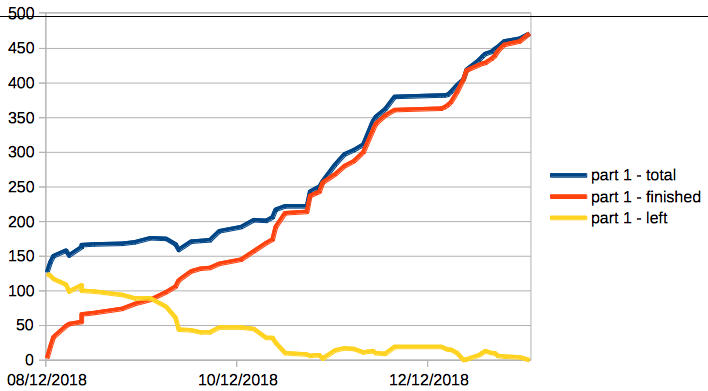Paradise Never Update II
Another, Less Dramatic Reworking
Vertical Slices
Writing this down mostly for my own benefit.
Sometimes after redesigning Paradise Never wholesale (starting in 2017) I decided to first tackle a vertical slice. I'd pick the smallest island and try to take it very close to completion.
Vertical slices are a standard approach to producing games. They make good logical sense: get a small part of the game completely completed, finishedly finished, totally totaled. Once you've done that, you should have a really good idea of what's left.
After finishing this slice I took a step back and worked on other things, mainly Venture the Void (now released-- hooray!) so I could come back at it with fresh eyes.
This chart tells the story:

The slice took about 2 months of content work, plus about 2 months of polishing. I estimate I have about 40 months of work left, in the most optimistic case. That's incredibly more time than I'm willing to put in, here.
Paradise Never is not the game, it's a game. Like, no regrets here— I've been doing a lot more with my life than PN these past years, but just in terms of games— that is one thing I want to do and I've sure got other stuff I want to get to!
It's incredibly important to be flexible. I mean this in... all things. Notice how a healthy tree bends with the wind. A dead one just snaps: so, bend or you will break!
Scale
Something that has been nagging me for awhile is that PN has a very strong auto-generation engine, but I am using it with a great deal of control. I have islands described in a lot of detail-- the type of rocks, terrain, vegetation, and so on. I then convince auto-generation to produce what I want.
All this control costs: it's actually (I think) somewhat harder to get auto-generation to produce something close to your vision, than it would be to just create it by hand in the first place. Auto-generation never was, and shouldn't be seen as a way to save on work, after all— but if you try to steer it too much you end up working against it and this does make it more work.
Why write auto-generation and then tell it what to do? The interesting thing is to just let it go.
The question for me is not so much scale, I think. It's not the number of islands laid out, or even the number of characters, quests, and so on. I've actually scaled this back pretty reasonably. It's the specificity that I have laid them out with.
Ultimatley it's very time consuming to make something happen in a particular way, and doubly-so if automatic generation is in the mix. So why do it?
Control
A thing I want to say in this quick note: I think the great game designers choice is all about how much control to exercise.
Cutscenes are one side of the spectrum. A cutscene is the game designer saying, "I want something to happen in a very specific way to create a very specific effect." Most cutscenes are not playable, because the tradeoff of wanting such a specific effect is that it's very difficult to achieve unless you control things very closely.
Any kind of open-ended, systems-based gameplay is the other end. Maybe we can even say, emergent gameplay is at the other end. It's the game designer saying, "IDK. Here's some things, that I think are interesting, have at 'er."
It's a really great paradox and discipline of game design to try and lean toward 2. Games tend to "sing" when they are leaning toward open-endedness. But it requires a certain mentality on the part of the game designer to let go and sort of say, "IDK. Really, I don't know what will happen."
This is actually a kind of humility, and one which we should find creatively freeing. Maybe you don't have to be genius to create an interesting game system, after all. Maybe you don't even have to be smart.
Adjust
The way forward for me is to just adjust a bit. Again. This is humbling, I wan't say demoralizing but maybe a tiny bit of a pill to swallow. Writing this blog post is partly so I can't trick myself into thinking I don't need to do this. But it definitely will not work to try and lay everything out with as much specificity as I had originally envisioned. I've had this sneaking suspicion all along, I think, but I guess I wanted to try this for a bit, at least.
Instead what I will do is step back a little bit and try to throw things a little more scattershot. This is less of a change in terms of the story or the interesting things I want to try and say, as it is a change in how I intend to realize it.
The next "slice" will be structured about the same scale as the vertical slice I took above, but it won't be vertical, per se. Instead I will tackle each of the components in the vertical slice, but across the entire game. I should build things up as a system of islands that are fun to explore but are essentially "story-less".
The story itself will then be broken down into less-strongtly-connected parts and laid on top of it.
I'd like to be in a good place with this in about 6 months. Based on my experience I should be able to scale the first slice, which will likely be terrain and scenery, into 2 months. The next 2 months for buildings and objects, and the last 2 months for (non-story-centric) NPCs.
I'll try not to look too far past this.
◀ Back